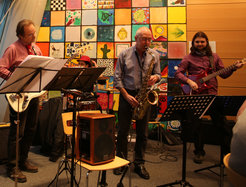The inner clock in music
Max-Planck researchers find universal laws of human music performance
Musicians do not reproduce rhythms with the precision of a machine, small deviations make up a part of the unique human music performance. Without such fluctuations, the so-called micro-deviations from the perfect rhythm, we mostly perceive music as artificial and expressionless. Göttingen researchers from the Max Planck Institute for Dynamics and Self-Organization (MPIDS) and the Bernstein Center for Computational Neurosciences (BCCN) have analyzed more than one hundred recordings of different styles, such as jazz, rock or pop and found that the micro-deviations of the played rhythms follow a universal, genre-independent principle. On different time scales, two different processes in our brain are responsible for these fluctuations. This result was recently published in the scientific magazine Plos ONE.
Understanding the magic of the music

Of all the arts created by humans, music is probably the least tangible one. The subtle mixture of sound and silence, of strict regulations and personal interpretation, of fulfilled expectation and elements of surprise touches our hearts, makes us dream and gives a rise to some unexpected emotions. A team of MPIDS and BCCN researchers around Viola Priesemann, head of a Max Planck research group and Theo Geisel, Emeritus Director at MPIDS, explores the secrets of music using statistical physics methods and the so-called chaos theory, in order to not only feel its magic, but also better understand this human phenomenon. Although music is a seemingly endless pursuit for perfection, there are small deviations and tempo fluctuations in our performances, some of which can only be measured in thousandths of a second, which give the music this little something.
From the lab to the stage
In an earlier extensive study, in which musicians had to drum differently complicated rhythms following a metronome under laboratory conditions, the Göttingen researchers found that these deviations influence each other over a very long time span. „It is as if the human brain has a lasting memory for these deviations,“ comments Theo Geisel. In the past, these remarkable results achieved under laboratory conditions have enabled scientists to develop a new „humanizer“, a program that makes computer-generated rhythms sound more natural to us. However, this was only the beginning of an exciting project. Real music takes place under more complex conditions and the musical context and genre probably play a certain role. Music pieces are often played by several people, who interact with each other at the same time. A common rhythm is created without the need for a metronome to set it from the outside. Göttingen researchers have now taken the important step from the laboratory into the real world of complex music performance and have analyzed more than one hundred original recordings of jazz, rock and pop songs, which were mostly recorded by the bands without using a metronome, i. e. without external timing. Viola Priesemann explains the scientific procedure: “From each recording we have extracted the sequence of cymbal beats, which form the rhythmic basis of the music piece, and measured the time intervals between two successive beats with the thousandth of a second precision, in order to be able to quantify the smallest rhythm deviations within a musical recording“. An average song contains about 500 to 1000 cymbal beats. The evaluation of the time series gained in this way gave amazing insights into the complex music performance of the bands.
Metronome inside the head
The long-term correlations of the fluctuations, which the researchers had already noticed in the laboratory, could also be proven in the real music pieces. The results also show that these fluctuations are generally controlled by two overlapping processes. On the one hand, it is an internal clock that provides an inner time frame in our heads and on the other hand, it is a motor process that controls our ability to perform a sound or beat at the desired moment of time. For the first time, the MPIDS scientists show that these two processes emerge on different time scales within a single piece of music. If one looks at the first and some immediately following cymbal beats, the rhythmic variations on this time scale would be mainly determined by the motor process. On long time scales, i. e. when comparing the fluctuations between, for instance, the first two and the last two cymbal beats, the process controlled by the internal clock becomes dominant. In the long term, the rhythm can only achieve the precision prescribed by this clock. „However, if the beat of a music piece is set by a metronome, it takes the role of the internal clock and the precision of the played rhythm becomes solely controlled by the motor process. The graphics show this very clearly,“ says the first author Mathias Sogorski. The interplay between these two processes seems to be a characteristic feature that influences our „freehanded“ music reproduction regardless of the genre.
Music genres under the microscope
Although both processes seem to occur universally, the researchers decided to compare the studied genres. They found that in contrast to the rock and pop songs, the jazz pieces exhibit a much higher rhythmic variation on short time scales, within a bar, characterized by the motoric process. This significant difference can probably be explained by the fact that jazz musicians tend to use micro-deviations from the given rhythm to give a piece of music a more personal touch, whereas pop and rock performers do not have such rhythmic freedom. On long time scales, where our internal clock sets the time frame, the genre difference has disappeared. „It is interesting that these long-term variations of the music pieces always seem to be similar, whether it is a Jazz or Rock,“ says Viola Priesemann, “They are characteristic of our internal clock.“ However, rhythm fluctuations are one of the strongest means of musical individuality and personal expression on short time scales. Using these fluctuations the humanity continues to create the most diverse and fascinating magic of music over and over again.
